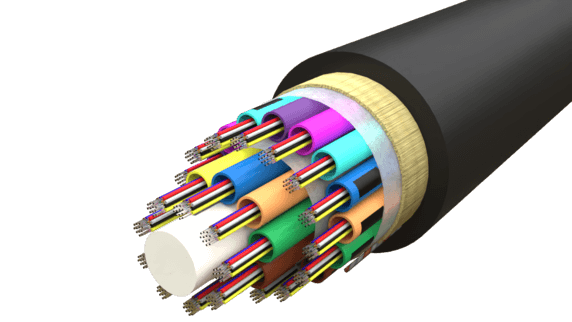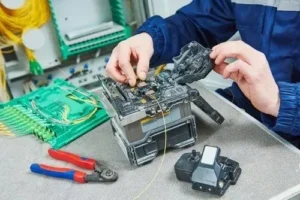In this article, we delve into the fundamentals of FTTH (Fiber to the Home) networks, highlighting some of the critical components . FTTH networks, which bring high-speed internet directly to residential areas, are composed of several key elements. These include the Optical Line Terminal (OLT), pivotal in initiating the fiber optic signal; the Optical Distribution Frame (ODF), which organizes and manages connections; and the Passive Optical Splitter (POS), responsible for dividing the optical signal to serve multiple premises. Additionally, the architecture incorporates Fiber Distribution Terminals (FDT) and Fiber Access Terminals (FAT) for further network distribution, Fiber Terminal Boxes (FTB) for end-user connectivity, along with Optical Distribution Boxes (ODB), Optical Splitter Boxes (OSB), and the Optical Network Units/Terminals (ONU/ONT), which convert optical signals into electrical signals at the user’s premises.
Access Node
At the heart of every optical access network, the Access Node stands as the initial step in delivering fiber connectivity to users. Its primary role is to secure all active transmission gear, oversee fiber connections, and ensure a smooth link between the fibers and the operational equipment. The scale of the Access Node directly correlates with the number of users it supports and its potential for future enhancements.
Typically, you’ll find Access Nodes nestled within the telecom operators’ Central Offices or encased in Telecom containers/shelters. To extend their reach to distant locations, they might also be stationed in outdoor cabinets, making connectivity accessible in more remote areas.
Within an Access Node, several key components play crucial roles:
- The Optical Line Terminal (OLT) initiates the fiber optic signal.
- The Optical Distribution Frame (ODF) organizes and manages the fiber connections.
Occasionally, a Passive Optical Splitter (POS) is included to divide the optical signal for distribution to multiple users.
This setup is designed to be flexible and scalable, ensuring that as the network grows or the needs of the area change, the Access Node can adapt to continue providing reliable service.
Optical Line Terminal (OLT)
The OLT is crucial at the beginning of the network, housed in a subrack equipped with slots for various boards. Depending on the model and the vendor, service boards may offer 8 or 16 GPON ports, each capable of supporting up to 64 end-users. This capacity varies, allowing for a less dense distribution of users per port by adjusting the split ratio.
At the network’s core, the OLT manages the flow and processing of data. It converts optical signals to electrical ones, directs network traffic, ensures protocol interoperability, allocates bandwidth, authenticates ONUs/ONTs, and monitors the network. Additionally, it provides administrators with a comprehensive overview of the PON infrastructure.
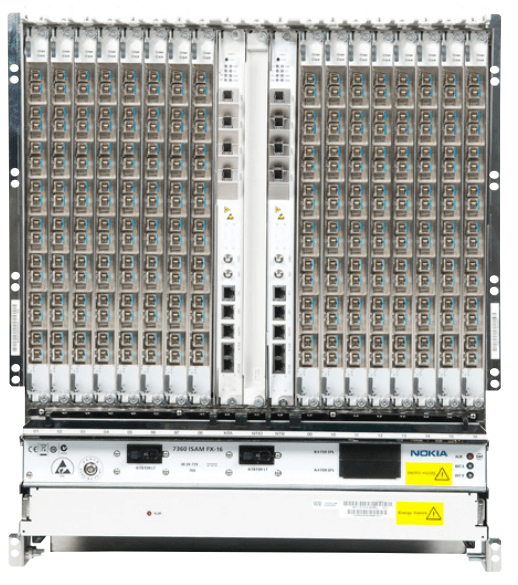

Optical Distribution Frames (ODF)
ODFs are crucial for organizing fiber optic cables. They come in rack-mount, wall-mount, and cabinet-mount varieties, each suited to different network needs. They’re designed for easy access, effective cable management, and protection, key for network reliability.
Rack-mount ODFs are notable for their modular design, offering flexibility with pre-assembled options featuring fiber optic adapters or open configurations that allow for custom assembly. These are typically installed in standard 19″ racks, catering to future expansion needs of fiber distribution frames.
Wall-mount ODFs present a compact solution for smaller fiber distribution tasks, often used in environments with limited optical cables and cores. Their design includes protection against environmental factors like rain and dust, making them suitable for both indoor and outdoor applications.
Cabinet-mount ODFs offer a secure, lockable structure for more extensive network setups, available in various configurations from open frame cabinets to fully assembled options including fiber patch panels and modular cassettes.
Mini ODFs and High-Density ODF Rackmounts address specific needs such as small-scale fiber capacity and enhanced optical density in networks, respectively. The latter is especially relevant for access layer deployments in telecommunication networks and FTTx applications, providing a scalable solution to manage and adapt fiber optic cabling efficiently.
Choosing the right ODF involves considering factors such as the installation environment, fiber capacity, and specific functional requirements. It’s crucial to select an ODF that not only fits the current network architecture but also accommodates future growth and technological advancements. High-quality ODFs are designed with features that ensure ease of access, effective cable management, and robust protection for fiber connections, contributing to the reliability and performance of the optical network.


Passive Optical Splitters (POS)
Passive Optical Splitters (POS) are key to Passive Optical Networks (PON) and essential in Fiber to the Home (FTTH) setups. They let a single optical fiber serve many endpoints, distributing signals widely without needing power.
In PONs, splitters split a fiber’s signal into multiple outputs, from 2 to 64, based on their capacity. This split extends the network’s reach and serves more users from one source. Splitters can also handle a 2:N setup, taking two inputs for more resilience and flexibility, useful when redundancy is critical.
There are two splitter types: Planar Lightwave Circuit (PLC) and Fused Biconical Taper (FBT). PLCs distribute signals evenly and fit well in dense networks thanks to their compact size. FBTs, while less uniform, are cost-effective and allow for custom splits.
The splitter choice affects network performance, including insertion loss, which measures signal reduction. Higher splits mean more loss, affecting reach and service quality.
By enabling a fiber to support many users without electric power, splitters cut costs and simplify networks. They’re used everywhere, from central offices with the Optical Line Terminal (OLT) to local points like Fiber Distribution Terminals (FDT) and Multi-Dwelling Units (MDU).

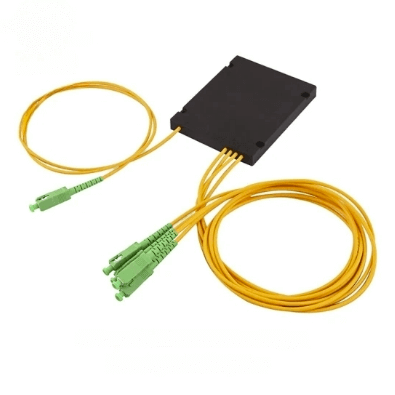
Fiber Distribution Terminal (FDT)
A Fiber Distribution Terminal (FDT), also known as an FTTH cabinet, is essential in Fiber to the Home (FTTH) networks. It centralizes connections, linking service provider fibers to homes or buildings. The FDT ensures efficient, secure signal distribution to subscribers.
Designed for many fibers, FDTs support splicing, termination, and storage in a protected enclosure. Some use splicing trays for organization and protection, vital for reliability in busy areas. Others include an Optical Distribution Frame (ODF) and patch panels for a traditional setup.
FDTs are weatherproof for outdoor use, allowing easy maintenance and expansion as the subscriber base grows.
FDT designs vary with network needs, home numbers, environments, and telecom technologies. Some feature passive optical splitters, splitting a signal into multiple fibers for efficient point-to-multipoint architecture in FTTH deployments.


Fiber Patch Cords and Connectors
A fiber-optic patch cord consists of a high-refractive-index core, encased in a low-refractive-index coating, reinforced by aramid yarns, and protected by an outer jacket. This structure allows optic signals to travel with minimal loss over long distances. The core’s transparency and the coating’s reflective properties keep the light focused, reducing signal loss. Aramid yarns and the jacket protect against physical damage.
Typically, fibers are 125 µm in diameter, with single-mode cables having a 9 µm core and multi-mode cables 50 or 62.5 µm. Innovations like “reduced bend radius” fiber have made cables smaller, saving space.
Patch cords vary by transmission medium, connector type, and the cover of the connector’s core. Single-mode fibers, usually yellow with blue connectors, cover longer distances, while multi-mode fibers, often orange or grey with cream or black connectors, are for shorter distances. Specialized versions, including armored, bend-insensitive, and low insertion loss cords, cater to unique needs, offering durability, flexibility, and efficiency.
Whether for basic connectivity or specialized applications, understanding the distinct features and applications of each fiber patch cord type is essential for optimizing network performance.


Fiber Optic Cables
Fiber optic cables are like the lifelines of modern networks, allowing for quick data transmission across long distances with little loss. These cables have a light-transmitting core of glass or plastic, encased in cladding that keeps light from escaping, and a protective outer layer to prevent damage. The thickness of the core and cladding depends on the cable’s use and performance needs. This technology has transformed telecoms, internet, and cable TV by enabling the fast, reliable transfer of huge data volumes.
There are two main types of fiber optic cables: single-mode and multimode. Single-mode cables, perfect for long-distance communication, carry one light signal and have the smallest core but the thickest covering. Multimode cables, in contrast, transport several light signals over shorter distances and come in two forms: step index and graded index, the latter designed for high-speed data needs in places like data centers.
Installing these cables requires specific methods to maintain performance and safety. Underground cables are blown or pulled through conduits, reducing stress and damage risk. Aerial setups hang cables from poles, linking network points without digging.
Joining two cables, or splicing, is key for network growth or repair. Cable quality is checked with optical time-domain reflectometers (OTDRs), tools that detect light loss and faults, ensuring network reliability and effectiveness.
Fiber Optic Closures
Fiber optic closures are essential components in the telecommunications industry, providing a secure space for splicing and protecting fiber optic cables. These devices, also known as fiber optic splicing closures, are crucial for maintaining the integrity of fiber optic connections, whether situated outdoors in harsh environmental conditions or indoors within buildings. Their robust mechanical strength and durable outer shells ensure that the delicate optical fiber joints remain unharmed by external forces, safeguarding the seamless transmission of data across networks.
There are two main types: horizontal and vertical.
Horizontal fiber optic closures, characterized by their flat or cylindrical shape, are typically used for aerial or underground cable installations.
Vertical closures, with their dome shape, are perfect for both above-ground and buried applications, offering high-capacity and adaptable designs.
Both types are waterproof and dustproof, designed to protect against environmental harm.
Choosing a closure involves considering cable types, port numbers, splicing methods, and grounding needs. It’s also important to pick the right hardware and manage cables effectively to prevent damage. By assessing these factors, operators can select the best closure for their network’s needs, guaranteeing its longevity and reliability.

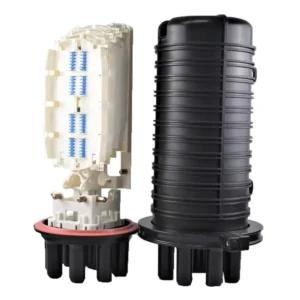
Fiber Access Terminals (FAT) and Fiber Terminal Boxes (FTB)
Fiber Access Terminals (FAT) and Fiber Terminal Boxes (FTB) are crucial for fiber optic networks. FATs are outdoor enclosures that manage and direct fibers to various locations, supporting fiber-to-the-home (FTTH) setups. They’re built to handle different environments, perfect for both overhead and buried setups.
FTBs, used indoors, connect and end fibers in buildings and data centers. They keep fiber ends safe, maintain signal quality, and allow easy maintenance.
Both FATs and FTBs vary in size and type, matching different network needs and spaces. Outdoor FATs are durable against weather, while indoor FTBs focus on accessibility and look. They make networks more flexible, scalable, and reliable by keeping fibers organized and protected, ensuring the network runs smoothly.


Optical Network Unit/Terminal (ONU/ONT)
In fiber-to-the-home (FTTH) networks, Optical Network Units (ONU) and Optical Network Terminals (ONT) are essential for high-speed internet. These devices link users’ homes to the fiber network, offering stable broadband access. ONUs and ONTs play similar roles but differ in functions, features, and uses.
An ONU connects a home directly to the fiber network, changing optical signals to electrical ones. This lets local devices use high-speed internet by connecting to the service provider’s network.
An ONT, an upgraded ONU, supports more services like voice, data, video, and multimedia. It often has Wi-Fi and Ethernet ports, letting devices connect directly. This versatility makes ONTs ideal for businesses or homes needing advanced connectivity.
Summary
This comprehensive guide explores the essential elements of Fiber to the Home (FTTH) networks that enable high-speed internet directly to residences. From Optical Line Terminals (OLTs) that kickstart the fiber optic signal, to Optical Network Units (ONUs) and Terminals (ONTs) that convert these signals for user devices, each element plays a crucial role in the network’s architecture. The guide covers the various devices and systems involved, such as Fiber Distribution Terminals (FDTs), Fiber Access Terminals (FATs), and Fiber Terminal Boxes (FTBs), which manage and distribute optical fibers throughout the network. It also delves into the specifics of network design, including the use of Optical Distribution Frames (ODFs) and Passive Optical Splitters (POS) for efficient signal distribution. Whether dealing with indoor or outdoor settings, the text explains the importance of choosing the right components to ensure network flexibility, scalability, and reliability.
For professional assistance with network planning, High-Level Design (HLD), Low-Level Design (LLD), long-haul connections, As-Built documentation, or the design and construction of GIS systems, our team is always ready to help.

